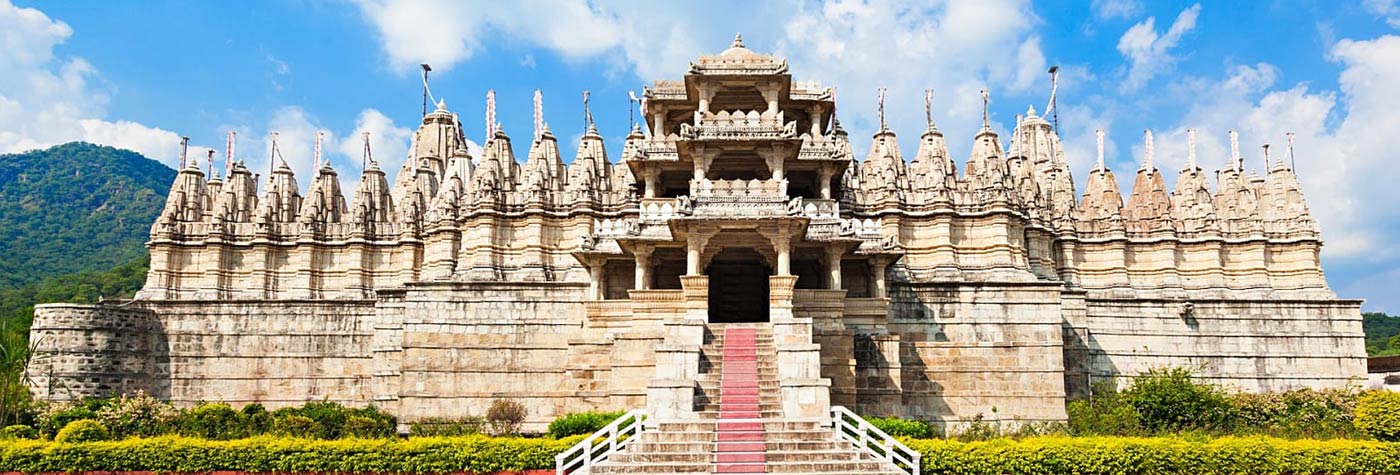Ranakpur Travel Guide
Ranakpur Travel Guide is an ideal place to visit if you want to explore the Rajasthan that was. Tucked away in a valley of the Aravalli range, halfway between Udaipur and Jodhpur, this place has a lot more to offer than you would think. This city is known for one of the most famous Jain temples in India, which is also one of the most significant sites of architecture in Rajasthan. The Chaumukha (with four faces) Temple is huge and word has it that each of the 1500 pillars is different in design. It is one of the most phenomenal establishments of Jain culture in the country! Two other Jain temples stand in equally beautiful fabrication in the same compound. A magnificent Sun Temple adds to the essence of spiritualism and the beauty of the compound. The Muchhal Mahavir Temple nearby is famous for housing a statue of Mahavira with a moustache. One can also stop at the neighbouring Garasia tribal village, renowned for their vivid and colourful clothes. Do take a ride on horseback through the forests to soak in the serenity and beauty.
About Ranakpur Jain Temple
Ranakpur Jain Temple (also known as Chaturmukha Dharana Vihara) is a Jain temple dedicated to Tirthankara Rishabhanatha. Ranakpur Temple is one of the largest and most important temples in Jain culture. It is considered as one of the 5 most sacred places for Jains. The name of the temple is borrowed from the village named Ranakpur in the Pali district, which lies between Udaipur and Jodhpur in Rajasthan. Adinath, Neminath, Parshvanath, Surya, and Amba Matha are the deities worshipped here. Among them, the Adinath temple that is, Chaumukha, is the most famous and well known.
History
In the 15th century, a local Jain businessman named Darna Shah was determined to build a beautiful temple after he was inspired by a dream of a celestial vehicle. He called many renowned artists and sculptors to submit their plans and designs for the temple, but none of them matched the beauty he saw in his dream. Then, an architect named Deepak from Mundara presented a plan in front of Darna which profoundly impressed him. Deepak was a very carefree artist; he was someone who would prefer poverty if it came with serenity. He was deeply touched by the devotion of Darna and promised to create a temple which would prove to be as beautiful as Darna’s dream. He approached Rana Kumbha, who was the king of the province then, for land to build his building. Not only did Rana provided him with the land but he also advised Darna to create a town near the temple.
The construction of the temple started in 1389 and it continued till 1458 CE. However, a different source mentions that the construction continued until 1496. According to the audio guide provided to the tourists at the temple, it took 50 years to be completed and approximately two thousand seven hundred and eighty-five workers were involved. The temple and the town were named Ranpur after the name of King Kumbha Rana. Ranpur is also popularly known as Ranakpur.
This temple was even invaded by the Mughals and was once used as a home for dacoits. After a few years, it was re-discovered as made as a tourist attraction for everyone to see.
Architecture
Ranakpur Jain Temple is renowned for its splendid architecture. This temple was mentioned in the list of the 77 nominees for the Seven Wonders of the World because of its divine and splendid ancient architectural design.
The structure of Ranakpur Jain Temple is highly complex, having four different doorways to get into the chambers. These chambers ultimately take you to the main hall where the image of Adinath is positioned. The construction of the temple is such that no matter which of the four doorways you use, you will end up in the main courtyard. The temple comprises of twenty-nine halls and eighty domes.
Ranakpur Jain Temple is a three-storied marvel completely made out of light-coloured marble. There is a sudden drop in the temperature; you can feel the coolness in the air in contrast to the scorching heat of Rajasthan. It is famous for its intricate carving, and sculptural work. The temple is made in the form of Nalini-Gulma Vimana, which was the heavenly vehicle Darna Shah saw in his dreams.
The magnificent structure of the temple provides a celestial aesthetic to the temple. It is spread over 48,000 square feet of land. What is more fascinating is that it is supported by around 1400 intricately carved pillars and legend says that no two pillars in the temple are the same. The pillars are carved with beautiful ancient designs and you cannot help but gaze at the beauty and the intricate detailing of the designs there. Also, don’t try counting the pillars because it is impossible to do so because there are just so many of them.
The ancient architecture is so efficient that there is no need for artificial lighting in the temple, it is only illuminated by the natural light of the sun. The beautiful marble takes on different shades throughout the day. Not only the pillars and ceilings but the marble elephant, distinctive domes, shikhara, turrets, cupolas, etc are among the main attractions of the temple. One starts experiencing a feeling of calmness when they hear the sound of the hundred and eight-kilogram bells tolling. Interestingly, the temple has 84 underground chambers built to protect the Jain idols from the Mughals. The temple’s main attraction is the beautifully carved idol of Parshvanatha which is made out of a single marble slab.

 +91 9799050299
+91 9799050299 


